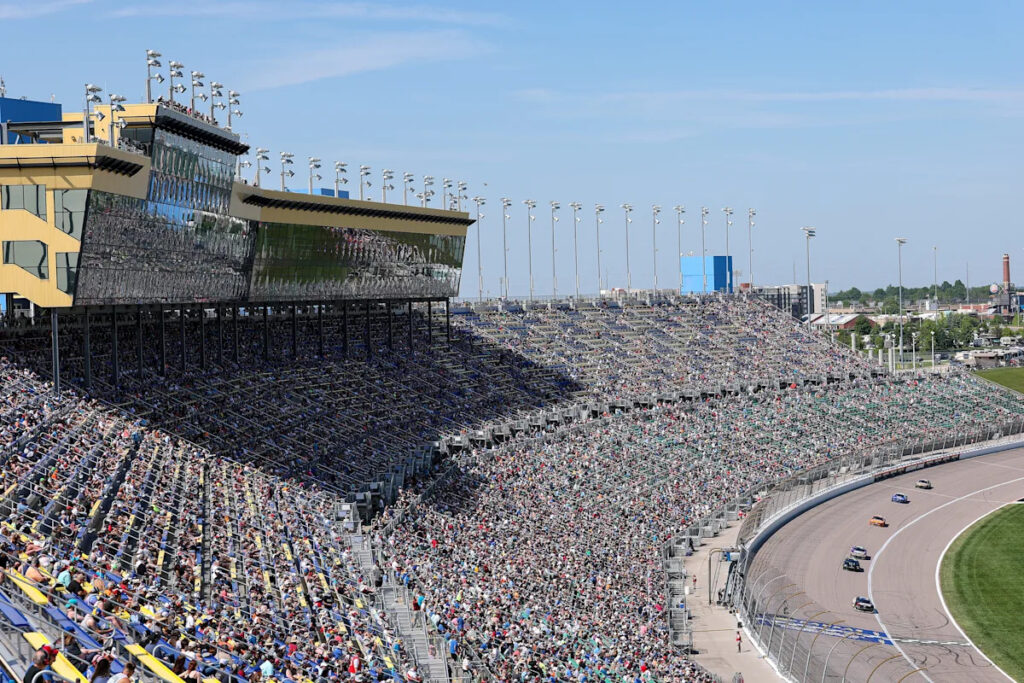Kyle Larson’s win at Kansas Speedway in front of a sparse crowd was a great example of the fundamental problem NASCAR faces as it navigates the 2020s and beyond.
To be clear, that problem has nothing to do with Larson’s excellence overall and his dominance on Sunday. He won all three stages and clearly had the fastest car, though there was a bit of drama on the final lap. Larson’s car slowed abruptly on the final lap as he nursed it to the finish line less than a second ahead of Christopher Bell. Had the race been 268 laps and not 267, Larson may not have been the winner.
Advertisement
Instead, the problem was with just how few people were in attendance to watch Larson get his second straight spring win at Kansas. After years of sellouts in the 2000s and 2010s, the grandstands on Sunday were roughly half-full. People had ample room to spread out, and if you looked closely, you could roughly see how the seats in the middle spell out “Kansas Speedway.”
Kansas is NASCAR’s best track. Why weren’t more fans in attendance? (Photo by Jamie Squire/Getty Images)
(Jamie Squire via Getty Images)
Kansas is the best track in NASCAR. The 1.5-mile oval’s asphalt has aged exceptionally with the rough-and-tumble midwest winters for great tire wear, and the progressive banking creates multiple racing lanes. It’s a three-lane track on its worst days and can produce four- and even five-wide racing immediately after restarts.
Just a year ago, Larson beat Chris Buescher in the closest finish in NASCAR history. Larson won the race by 0.001 seconds after the immediate timing and scoring loops showed Buescher had crossed the finish line first.
Advertisement
Yes, the close finish was the product of a restart with two laps to go, but it was a fitting way to describe just how good the racing has been at Kansas. If the track were located a few hundred miles south, it’d be a no-brainer candidate to host a championship race in early November, when NASCAR starts rotating the site of its title races after the 2026 season.
But will fans show up even if Kansas did get a title race?
Marketing the best track in NASCAR should be easy. Yes, Sunday’s race was held on Mother’s Day and high school graduation season is in full tilt in Kansas City. But the local buildup to the race was nearly non-existent. NASCAR weekends were big-time events in this city for years. They’ve felt like an afterthought recently.
Advertisement
That can’t be only a Kansas City problem, either. NASCAR has heavily cut back on its public-relations departments in recent years in the name of cost savings. It’s hard not to see a correlation between those cuts and a lack of promotion.
NASCAR still can tout itself as the top motorsport in the United States. A week ago, the Cup Series race at Texas Motor Speedway went head-to-head with the Formula 1 Miami Grand Prix. The Cup race got more TV viewers than the Miami Grand Prix on ABC did even though the NASCAR race was on Fox Sports 1. But the F1 race easily won the coveted 18-49-year-old demographic in both total number and share. Over a third of the F1 viewers were in that age range. Less than 20% of NASCAR’s viewers were.
It’s still hyperbolic to say NASCAR is facing an existential crisis. TV ratings for the Cup Series have stabilized after years of declines, and NASCAR is in the first year of its new TV deal. But it’s also fair to say NASCAR has little hope of getting back to the heights it experienced 20 years ago. If NASCAR can’t come close to filling the grandstands for its best product, how can it say that everything is OK?
Read the full article here



